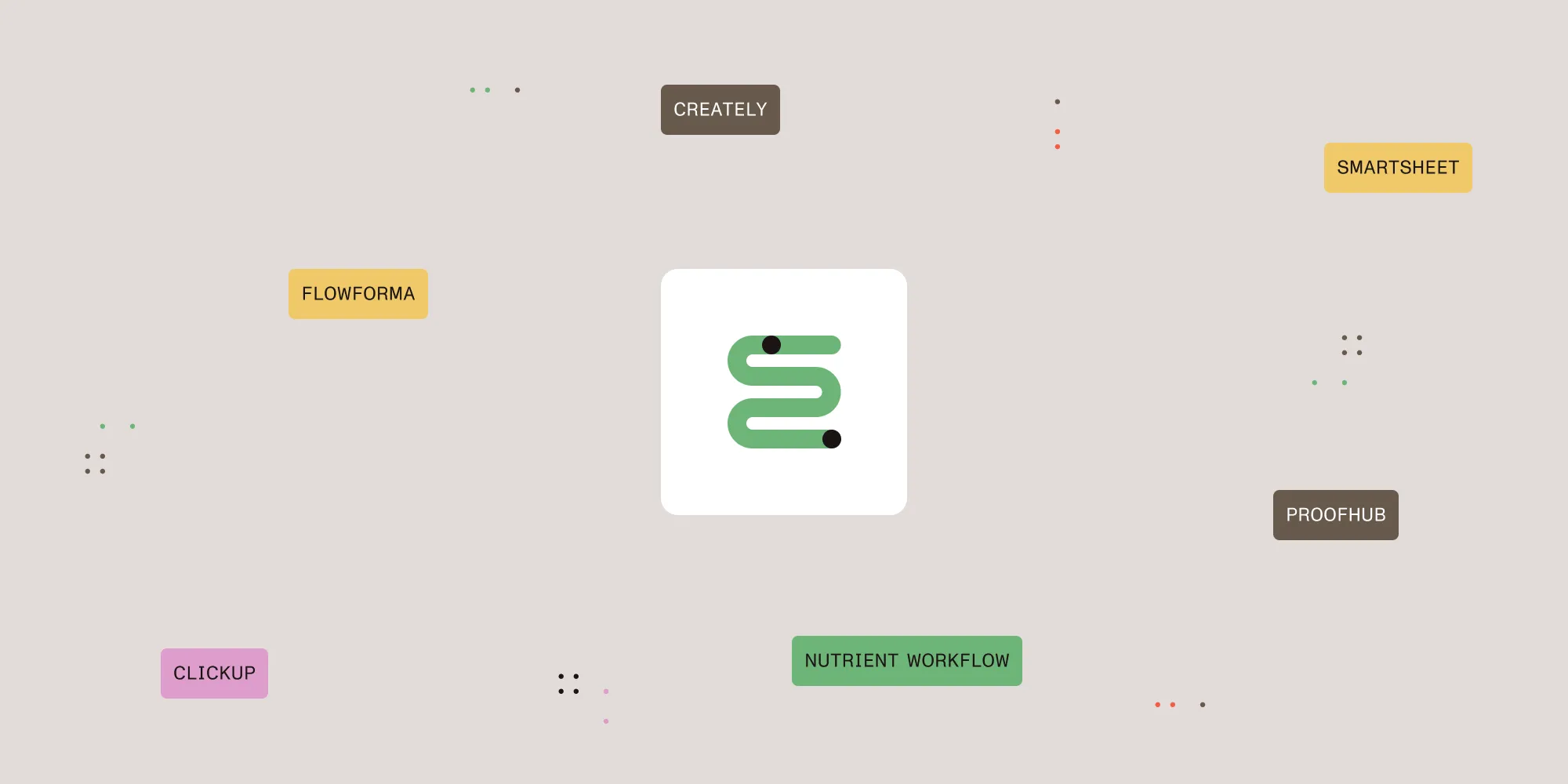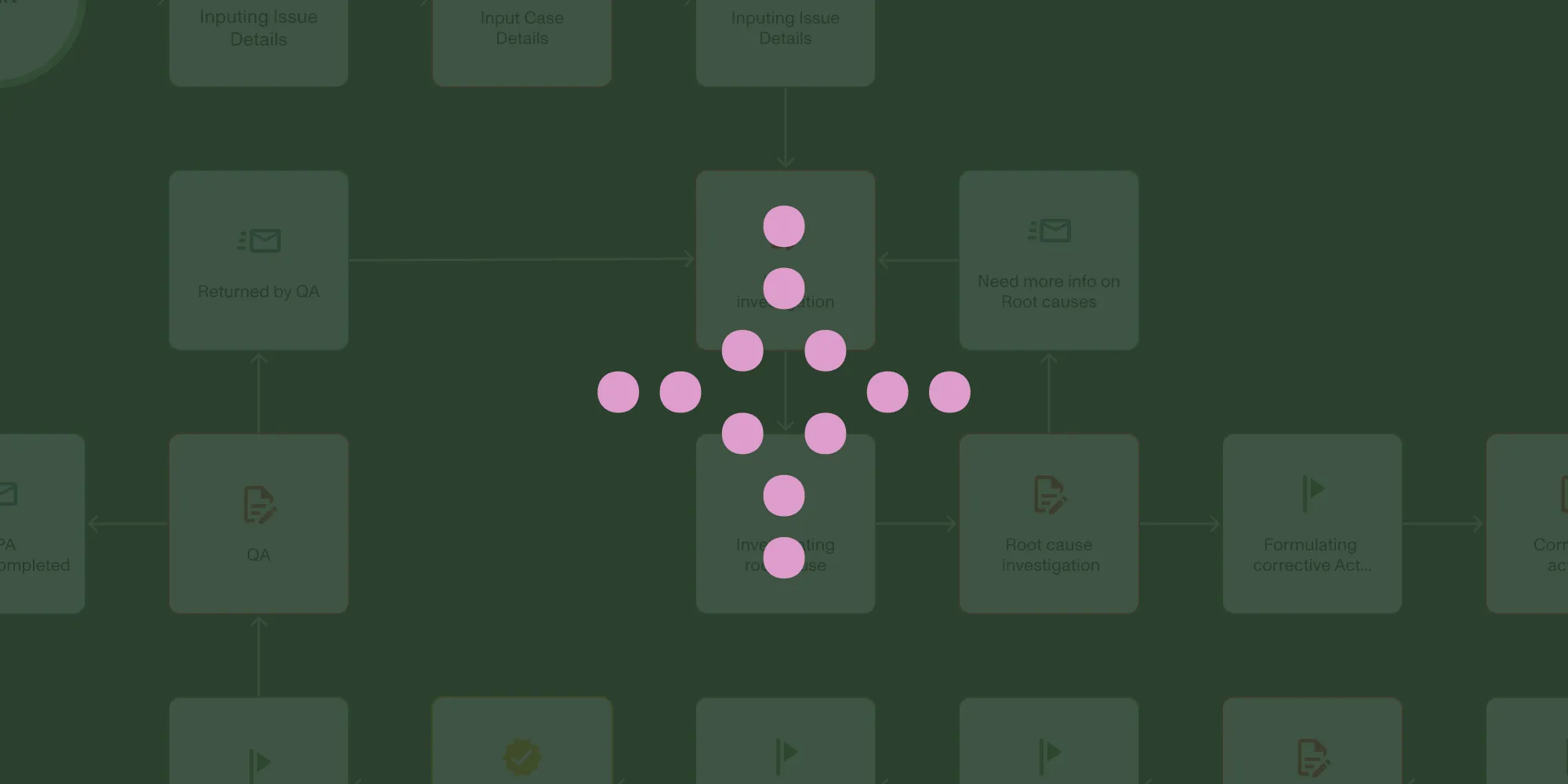Workflow process: Definition, components, and best practices
Table of contents

Try Workflow Automation free for 14 days
A workflow process is a structured sequence of tasks, decisions, and activities designed to achieve specific business outcomes efficiently. Key components include activities, decision points, participants, and information assets. Well-designed workflow processes improve operational efficiency, reduce errors, and enable better resource allocation. Success depends on thorough current-state documentation, flexible design, and continuous improvement practices.
Effective workflow processes serve as the backbone of organizational operations, enabling teams to complete complex work systematically while maintaining quality standards and accountability. They provide clear pathways for work to flow through an organization, defining who does what, when, and how.
Watch a workflow being automated

Key workflow process terminology
Workflow mapping
Process mapping creates visual representations of workflow processes, illustrating task sequences, decision points, and resource flows. This documentation technique helps teams understand current workflows and identify optimization opportunities.
Workflow orchestration
The workflow engine serves as the central coordinator that manages task execution, routing work between participants, and enforcing business rules. Modern workflow engines handle both human tasks and automated system integrations.
Process optimization
Workflow analysis involves systematic evaluation of existing processes to identify bottlenecks, redundancies, and improvement opportunities. This analysis informs strategic decisions about workflow redesign and automation priorities.
Workflow governance
Business process management provides the framework for designing, implementing, and optimizing workflow processes across organizations. It ensures workflows align with business objectives and compliance requirements.
Cross-functional coordination
Task orchestration manages dependencies between activities, ensuring work progresses smoothly across departments and systems. Effective coordination requires clear handoffs, status visibility, and accountability mechanisms.
Optimize your workflows — Save time, reduce errors, and automate tasks effortlessly. Start your free trial today!
Types of workflows
There are many types of workflows common across all industries and departments; here’s a selection of the most common processes.
| Category | Requests/approvals |
|---|---|
| IT/IS | IT service requests |
| Security access requests | |
| New account setup | |
| Change requests | |
| New project requests | |
| Security incidents | |
| Software asset management | |
| Finance | CapEx/AFE requests |
| Expense approvals | |
| Salary/wage changes | |
| AP automation | |
| Grant management | |
| Marketing | Campaign approvals |
| Collateral approvals(opens in a new tab) | |
| Brand management | |
| Facilities | Office relocations |
| Resource scheduling | |
| Facility access | |
| Move requests | |
| Sales | Quote approvals |
| Pricing discounts | |
| Proposal approvals | |
| Product discounts | |
| Legal | Legal holds |
| Contract reviews | |
| Client intake | |
| HR | Benefits changes |
| Timesheet approvals | |
| New hire management(opens in a new tab) | |
| Employee onboarding | |
| Employee offboarding | |
| Vacation requests | |
| Purchasing | Procurement process |
| Capital approvals | |
| Vendor management | |
| Invoice approvals | |
| Product pricing | |
| Operations | Complaint management |
| Maintenance request | |
| New product request |
Essential workflow process components
Every effective workflow process consists of fundamental elements that work together to transform inputs into desired outcomes. Understanding these components is essential for designing workflows that deliver consistent results while minimizing inefficiencies.
Activities and tasks
Workflow activities represent the actual work performed within a process, ranging from simple data entry to complex decision-making. Each activity has defined inputs, outputs, and success criteria that determine workflow progression.
Activities are structured based on their execution requirements:
- Sequential activities follow a linear path where completion of one triggers the next
- Parallel activities execute simultaneously to accelerate overall process completion
- Conditional activities execute based on specific criteria or decision outcomes
- Automated activities run without human intervention through system integrations
Decision points and routing
Decision points determine workflow path selection based on predefined criteria, data values, or user input. These conditional branches ensure work follows appropriate routes based on specific circumstances.
Participants and roles
Workflow participants include individuals, teams, or systems responsible for executing activities. Clear role definition ensures accountability and prevents confusion about responsibilities.
Data and documents
Information assets flow through workflow processes, being created, modified, approved, or consumed at various stages. Proper data management ensures information integrity and availability when needed.
Workflow process example: Employee onboarding
This employee onboarding workflow demonstrates how multiple departments coordinate through a structured process. The workflow includes both automated activities (sending welcome emails, creating system accounts) and human tasks (document review, equipment setup, orientation scheduling).
Key workflow elements in this example:
- Triggers: Job offer acceptance initiates the process
- Parallel paths: IT setup occurs simultaneously with HR documentation
- Decision points: Equipment needs determine provisioning requirements
- Handoffs: Clear transitions between HR, IT, and management responsibilities
- Completion criteria: All tasks must finish before employee start date
Workflow process optimization benefits
Well-designed workflow processes deliver measurable improvements across operational, strategic, and organizational dimensions. Organizations typically experience immediate efficiency gains while discovering additional value as processes mature.
- Streamline and speed up internal workflows by reducing manual entry and request handling.
- Track request status (completed, pending, or in progress, etc.) in real time
- Identify performance trends (group and individual) over time.
- Identify process redundancies.
- Switch from single to parallel processing of tasks.
- Eliminate circumvention of organizational business rules.
- Provide staff members with reminders and alerts when tasks age.
- Allow 24/7 access to approve and monitor requests and tasks.
- Allow staff and management to focus on value-added projects instead of repetitive tasks.
- Reduced license overhead for enterprise systems (ERP, CRM, etc.).
- Monitor team progress against service level agreements.
- Identify and remove process barriers or bottlenecks.
- Reduce errors and re-work.
- Reduce the risk of improperly approved requests, contracts, hires, etc.
- Improve compliance with audit trails.
- Increase output and increase productivity.
- Provide a unified, personalized request workflow experience for employees.
- Better align tasks with the skillsets of and assign tasks to the most appropriate staff members.
- Drastically reduce paperwork and associated costs and waste.
- Reduce the need for manual decision-making and handling of business rules.
Workflow process design best practices
Creating effective workflow processes requires strategic planning and attention to key design principles. These foundational practices ensure workflows deliver intended outcomes while remaining adaptable to changing business needs.
Document current state thoroughly
Successful workflow design begins with comprehensive analysis of existing processes. Map current activities, identify pain points, and understand information flow patterns before designing improvements. This foundation prevents costly redesign efforts later.
Design for flexibility and scalability
Workflow processes must accommodate changing business requirements and volume fluctuations. Build in configurable decision points, modular task structures, and clear escalation paths that can evolve with organizational needs.
Implement governance and continuous improvement
Establish clear ownership, performance metrics, and regular review cycles for all workflow processes. Monitor key performance indicators and gather user feedback to drive ongoing optimization efforts.
Nutrient Workflow’s approach to workflow process automation software
Nutrient Workflow focuses on providing a platform for building customized, department-specific, and use case-driven automated workflows. Since no two companies are alike, we built Nutrient Workflow to be flexible and extensible to meet your organization’s business workflow management goals. Workflow software plays a crucial role in enhancing team collaboration and process management.
Flexible — Define workflows from scratch, start from a template, or have our experienced service team build what you need. Our software allows you to decide how your workflow runs. Choose tasks from various options and put them in the order your business rules dictate.
Powerful — Some of the largest companies in the world rely on Nutrient Workflow to reliably power their most critical workflows (think cybersecurity response, customer onboarding, capital expenditure requests, etc.).
Extensible — Connect to other systems and embed widget versions of your forms wherever you need them, including intranets, webpages, and other systems like SharePoint.
Service — In addition to being a robust, flexible workflow automation platform, Nutrient Workflow provides white-glove onboarding and process design by seasoned, professional implementation staff. Get up and running quickly with guided help and hands-on work from the Nutrient Workflow team.
Interested in automating your workflows?
If you’re interested in learning more, you can schedule a 30-minute live, guided demonstration(opens in a new tab) or try Workflow Automation free for 14 days.
Related
FAQ
Workflow processes enhance efficiency, reduce errors, and improve productivity by streamlining operations and ensuring tasks are completed in a systematic manner.
Automation reduces manual tasks, minimizes human errors, and allows for faster processing, leading to significant time savings and increased accuracy.
While all industries can benefit, sectors like finance, healthcare, and IT see significant improvements in efficiency and compliance through workflow automation.
Bottlenecks can be identified by analyzing task completion times, monitoring delays, and collecting feedback from team members to pinpoint where processes slow down.
Yes, most workflow automation tools allow for customization to fit the specific needs and rules of your organization, ensuring a tailored approach to process management.
Learn how to design a process by reading our blog on how to design a process.
Read our blog about how to write process documentation.
Check out our blog about thebest workflow management software to learn more about available tools and considerations.
You’ll find many great ideas for processes and workflows that can be automated on our workflow examples page.








